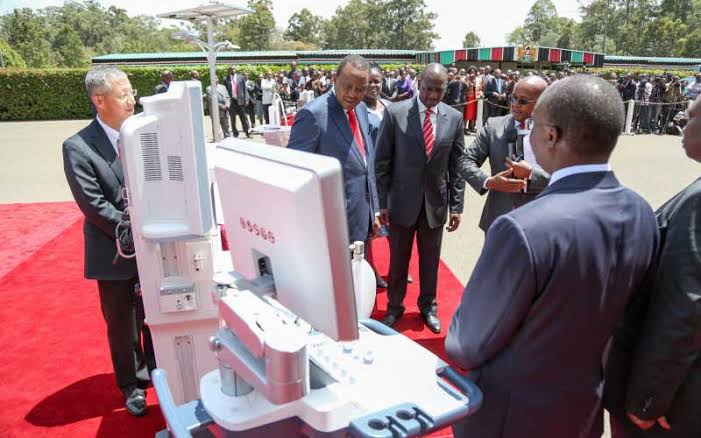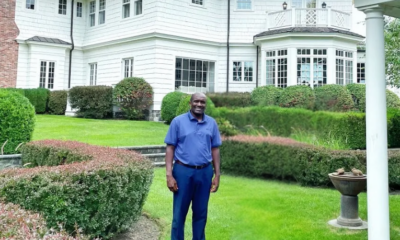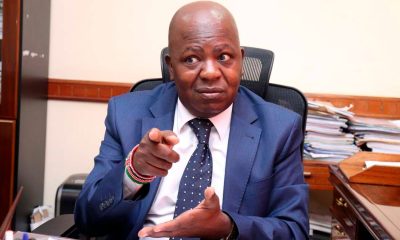News
The Mess That Was Sh68B MES Program

NAIROBI (Reuters) – Kenya’s health minister celebrated the delivery of a CT scanner at a large county hospital, telling journalists that sick patients could now be diagnosed locally.
Nine months later, the scanner has never been used: the hospital has no radiologists. Patients must still travel 160 kilometers from central Nyandarua to Nairobi’s overwhelmed Kenyatta National Hospital, where getting scans can take months.
Kenya won praise from international lenders in 2015 for launching Africa’s biggest public-private healthcare program, an unprecedented seven-year scheme to spend hundreds of millions of dollars leasing medical equipment from foreign firms.
At the time, the World Bank described the program as a model that could be rolled out to other African countries, a cost-effective way to obtain expensive equipment that requires specialist staff and resources to service.
But five years on, high tech machines are lying idle in more than a third of the hospitals that received them, according to data from the Ministry of Health and the doctors’ union.
Critics say the program has worsened the country’s debt burden and diverted urgently needed resources from basic healthcare that would otherwise save lives. They warn that the same costly mistake could be made in other African countries, where lenders are still promoting similar schemes.
“It’s very disappointing that the government missed the opportunity to do something great for the health care system because it wanted to do procurement,” said Dr Ouma Oluga, head of the Kenya Medical Practitioners, Pharmacists and Dentists Union, which estimates Kenya would 10,000 more medical staff to operate the new equipment. “I think it’s criminal.”
“BETRAYAL OF TRUST“
The government leased the equipment under a 38-billion-shilling ($370 million) deal with foreign companies including China’s Shenzhen Mindray, India’s Esteem Industries, General Electric and Philips.
According to Mutula Kilonzo, a lawmaker on a Kenyan senate committee that investigated the deal, its cost nearly doubled to 63 billion shillings as the health ministry ordered more equipment.
General Electric, Medtronic and Philips told Reuters they fulfilled their contracts by delivering and installing the equipment. GE said out of the 585 items it had leased to the government, “13 are not in use but will be fully functional once they are powered.” The other two companies did not respond to requests for comment. The senate committee has not accused the foreign companies of wrongdoing.
Edward Ouko, who left office last year after eight years as Kenya’s first auditor general, a post tasked under the constitution with tracking public funds, told Reuters the health ministry had not asked hospitals about their needs before supplying them with identical sets of equipment.
The ministry rebuffed his repeated requests to review the contracts, he said. He described the deal as a “betrayal of the trust of the Kenyan taxpayer”.
Ouko said funds would have been better spent on expanding basic healthcare, adding that more midwives and more clinics might have saved more lives in a country where 342 women die from pregnancy complications per 100,000 live births.
Neither the ministry’s spokeswoman nor the permanent secretary for health responded to requests for comment.
In October, Health Minister Sicily Kariuki told parliament that regional governments of Kenya’s counties had been asked about their equipment needs. However, five county governors have denied their administrations were consulted.
“LOOTING OPPORTUNITY“
When Kenya announced the leasing scheme in 2015, the World Bank praised the government for being the first in Africa to adopt a contracting model widely used in developed countries.
The Bank is still encouraging other African states to follow Kenya’s example by shifting procurement budgets to leasing contracts, which include the cost of servicing equipment. Such contracts provide a way for hospitals to ensure that machines are properly maintained, the Bank says. Otherwise, hospitals can end up as graveyards of equipment that falls into disrepair.
Khama Rogo, the World Bank’s top health sector specialist in Africa, acknowledged that there were problems in how the contracts had been carried out in Kenya, but said the principle of acquiring medical equipment through leases was still sound.
“It is a fault of the contracting, it’s not the concept,” Rogo said. “We can’t throw the baby out with the bath water.”
He also said the World Bank had offered Kenya free advice on structuring its contracts, but the government did not take it.
Oluga, the doctors’ union head, said government officials viewed the vast new equipment leasing program as an opportunity to divert health spending from basic care into procurement, a form of expenditure prone to corruption.
“The people who are at the top of decision-making in our health care system look at the system first from a looting opportunity: ‘How much can I make?’ No one is interested in the interaction of the patient and the health care system.”
SURGERY BY MOBILE PHONE LIGHT
Some of the new equipment has been useful. Reuters spoke to staff at the main hospitals in the towns of Naivasha and Embu who said dialysis machines they had received through the leasing deal had enabled them to improve care for patients.
But Kenya’s health sector faces huge challenges. Doctors say power cuts and shortages of basics like gloves and medicine often force them to improvise, including performing surgeries by the light of cell phones. Public hospitals often ask patients to find their own blood donors.
A CT scanner at King Fahad hospital in coastal Lamu County has been out of service since October because the local county lacks a dye needed to interpret the scans, top county health official Ann Gathoni told Reuters.
So 36-year-old Fatma Kasimu, who was suffering from stomach pains after giving birth last year, had to spend nearly 11,000 shillings ($110) to travel to the city of Mombasa for a scan, nearly a month’s wages for her fisherman husband.
At Garbatulla hospital in northeastern Isiolo County, there is not enough electricity to power radiology and surgical equipment, said four staff who did not want to be identified for fear of being fired. At other locations, equipment goes unused because of water shortages and insufficiently trained or absent staff, hospital employees said.
Most people need only primary health care, said Dr Githinji Gitahi, chief executive officer at Nairobi-based aid agency Amref Health Africa, which runs programmes in 35 African countries. But fancy equipment — even if unused — scores more points with voters.
“That’s why we ended up with such a high level of waste.”
Kenya Insights allows guest blogging, if you want to be published on Kenya’s most authoritative and accurate blog, have an expose, news TIPS, story angles, human interest stories, drop us an email on [email protected] or via Telegram
-

 Business2 weeks ago
Business2 weeks agoManager Flees Safaricom-Linked Sacco As Fears Of Investors Losing Savings Becomes Imminent
-

 Investigations5 days ago
Investigations5 days agoBillions Stolen, Millions Laundered: How Minnesota’s COVID Fraud Exposed Cracks in Somali Remittance Networks
-

 News6 days ago
News6 days agoUS Moves to Seize Luxury Kenya Properties in Sh39 Billion Covid Fraud Scandal
-

 Investigations5 days ago
Investigations5 days agoJulius Mwale Throws Contractor Under the Bus in Court Amid Mounting Pressure From Indebted Partners
-

 News6 days ago
News6 days agoMAINGA CLINGS TO POWER: Kenya Railways Boss Defies Tenure Expiry Amid Corruption Storm and Court Battles
-

 Americas5 days ago
Americas5 days agoUS Govt Audits Cases Of Somali US Citizens For Potential Denaturalization
-

 Americas7 hours ago
Americas7 hours agoTrump Says US Needs Greenland For Its National Security
-

 Sports4 hours ago
Sports4 hours agoWhat Makes Yesplay the Go-To Gambling Platform for South Africans?









